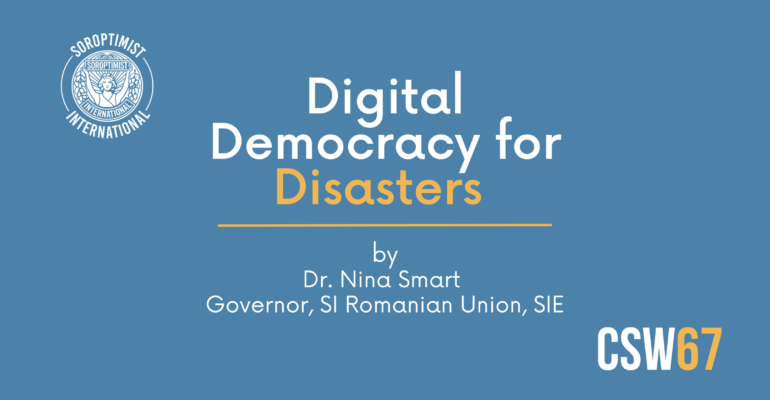CSW67 offered us the opportunity to participate live at the United Nations in New York and learn from the speakers who shared information specific to their communities. One such event, organised by the Soroptimists from the Soroptimist International South East Asia Pacific (SISEAP) Federation, was held on Thursday 16 March. The event offered a fresh perspective on how SI programmes have had to shift their focus to better address pressing local needs.
We learned that out of the 13 countries in the SISEAP Federation, all but one (Mongolia) have long, low coastlines, and all 13 experience disasters such as cyclones, typhoons, floods, droughts, fires, earthquakes, tsunamis, volcanic eruptions, and pandemics on a regular basis. Only 50% of countries have early warning systems (World Meteorological Organisation, 2023)[1]. Recovering from such disasters is always a challenge, and it is now more important than ever for both responders and their communities to apply new approaches on how to rebuild resilience. We learned that Soroptimists act as responders to disasters, supporting their communities and helping to recover quickly from nature’s wrath.
The presenters were SISEAP President, Christine Johnstone, SISEAP Programme Director, Dr. Donnell Davis, Dr. Ramona Miranda from UNDRR Stakeholder group for United Nations Disaster Risk Recovery SENDAI Framework, and Judy Toll, SISEAP Delegate to CSW. They each highlighted the importance of creating programmes that are sustainable. The ‘why, what, who, where and how’ of disaster relief works were addressed from the start. Disability, vulnerability, elderly, children comprise the target population for the SI programmes. Islands, rural areas, remote and isolated from communication are the areas where the programmes operate and the most important ‘how’ was answered by better communications that save lives. Improved digital disaster warning and crisis management systems could provide critical support to the region as it prepares for future disasters.
Four priorities were established through the SENDAI video presented at the start of the presentation:
- Understanding disaster risk
- Strength of disaster risk governance
- Investing in disaster risk reduction
- Importance of disaster preparedness
The seven targets of the SENDAI framework approach are:
- Reduce global mortality rate
- Reduce number of people affected (displaced)
- Reduce direct disaster economic loss
- Reduce damage to infrastructure
- Increase number of countries with disaster release structure
- Increase international cooperation to developing countries
- Increase public access to early warning systems
It was noted that the Sustainable Development Goals (SDGs) addressed are: SDG 5 (gender equality) SDG 6 (water) SDG 13 (climate change) SDG 16 (good governance) and SDG 17 (partnerships).
We learned that disasters are occurring more often and human intervention reduces vulnerability through community mitigation, social cohesion, coping capacity and good governance. The aim is to save lives, bounce back quickly and resettle peacefully. An example was given, illustrating that the highest risk populations in the region are women in Papua New Guinea, and people with disabilities and older people in Indonesia. The session focused on how women work well in disasters.
The presenters effectively engaged the audience by inviting us to use our phones to scan a code for the survey and presenting the results at the end of the session. This was very interactive as it engaged everyone present in the audience and online. You may view their video of the event to better understand how technology was efficiently used during the event by involving audience participation. This demonstrated digital democracy.
SI projects were presented to show disaster relief efforts that assisted 3 schools, 3 communities, and 1,300 students who benefited from the donations that were made. As we viewed pictures, it was highlighted that in Klang Valley, Malaysia, the weather alerts proved useless because the text message warnings were not received.
Soroptimists used the “3 days, 3 weeks, 3 months and 3-year” approach to assist during this disaster. Funding was generated through the President’s Appeal to provide clean water, then capacity building and training programmes. There were 12 sessions of sewing classes per month so that the women could set up their own small businesses. Other programmes involved literacy and mathematics as well as organic farming.
The COVID-19 pandemic was another major disaster during which 2,300 SISEAP members created masks, helped with mental health online forums for elderly, and provided food for those in need.
Conflict country donations have been directed towards Soroptimist networks supporting displaced peoples. These include Ukraine, Afghanistan, and Syria.
Lately there have been more floods, so the focus of Soroptimist programmes in the region has changed to a response based on disaster. The shift has been from normal SI work to disaster work.
It was highlighted that Soroptimists succeeded by their ability to look at the big picture, help with immediate actions, and at the same time they found effective ways to continue looking after the young people. Partnerships have been key to strengthening the projects. Using digital apps and engaging entrepreneurs are other ways that have been helpful to develop the programmes. It was concluded that it is very important to take the information back to the Government, enabling better decisions for communities and managing resettlement in their risky environments.
In the Q&A session, there were questions on how the disaster relief model could be applied to other areas such as Northern California. The audience were also asked to prioritise actions and to contribute their personal recommendations for improvement.
It was empowering to learn about the new direction SI programmes are taking and how Soroptimists are making a significant impact in their communities, empowering not only women and girls but everyone affected by the disaster, as well as engaging in preparation and prevention work.

[1] Source: https://public.wmo.int/en/programmes/disaster-risk-reduction-programme

